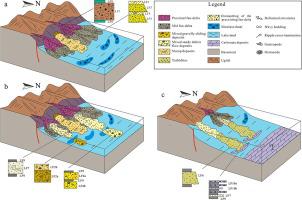Journal of Asian Earth Sciences ( IF 3 ) Pub Date : 2021-01-16 , DOI: 10.1016/j.jseaes.2021.104671 Maosong Ye , Xinong Xie , Rudy Swennen , Changgui Xu , Xiaofeng Du , Xuebin Du

|
Mixed siliciclastic-carbonate sediments have been widely studied, especially those of marine origins. However, it is rarely investigated in continental settings. Boreholes from the Qinhuangdao-A (QHD-A) block in central Bohai Bay Basin sampled lacustrine mixed sediments during the Eocene period (32–38 Ma), providing an opportunity to facilitate this aspect of research. Here, an integrated study of seismic, core data, and microscopic analysis revealed the formation and evolution of the mixed sediment system. Core observations and microfossil identifications show that mixed sediments characterizing volcaniclastic sand and gravel mixed with bioclastic debris are composed of shallow-depth biota assemblages. The relatively warm climate, low tectonic activity and low siliciclastic influx may result in prevailing occurrences of nearshore biota. Preexisting siliciclastics featuring a well-rounding shape experienced secondary transportation to mix with the nearshore biota, forming the major mixing type (compositional mixing). Seismic data, well-logs, and lithofacies logs divided mixed sediments into three evolutional units (U1-U3). U1 and U2 were dominated by “compositional mixing”. Within the U1, it occurred locally due to high sediment input during the low-level period. Peak took place in the U2 because lake-level rise led to increasing accommodation and decreasing siliciclastic influx. With further deepening of water depth in the U3, shallow-depended biota was not well developed and carbonates increased. Lake-level change results in a distinct depositional sequence of mixed sediments that bioclastic particles mixed with siliciclastics in shallow period and centimeter-scale carbonates interbedded with siliciclastic beds in the highstand. These findings bring new insights into mixed deposits, especially in continental settings.
中文翻译:

湖相混合沉积体系的沉积特征:以渤海湾盆地近海石ji头隆起为例
混合硅质-碳酸盐沉积物已得到广泛研究,尤其是海洋来源的沉积物。但是,很少在大陆环境中进行调查。渤海湾盆地中部秦皇岛-A(QHD-A)区块的钻孔在始新世时期(32-38 Ma)采样了湖相混合沉积物,为促进这方面的研究提供了机会。在这里,对地震,岩心数据和微观分析的综合研究揭示了混合沉积物系统的形成和演化。岩心观测和微化石识别表明,火山碎屑和碎石中混有生物碎屑的混合沉积物是由浅深度生物群落组成的。相对温暖的气候,较低的构造活动和较低的硅质碎屑涌入可能导致近海生物群盛行。先前具有良好圆形形状的硅质碎屑经历了二次运输,与近岸生物群落混合,形成了主要的混合类型(成分混合)。地震数据,测井和岩相测井将混合沉积物分为三个演化单元(U1-U3)。U1和U2以“成分混合”为主。在U1内,它是由于在低水位期间大量的泥沙输入而局部发生的。U2峰达到顶峰的原因是湖水位上升导致容纳量增加和硅质碎屑涌入量减少。随着U3水深的进一步加深,依赖浅水的生物群发育不佳,碳酸盐增加。湖泊水位的变化导致混合沉积物有明显的沉积顺序,即在浅期生物碎屑颗粒与硅质碎屑混合,而在高架层中夹杂着厘米级碳酸盐与硅质碎屑床。这些发现为混合矿床带来了新的见解,尤其是在大陆环境中。


























 京公网安备 11010802027423号
京公网安备 11010802027423号